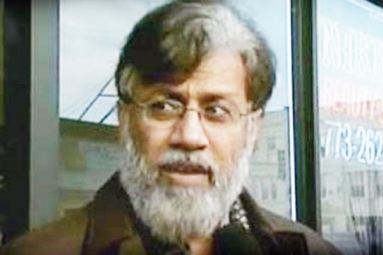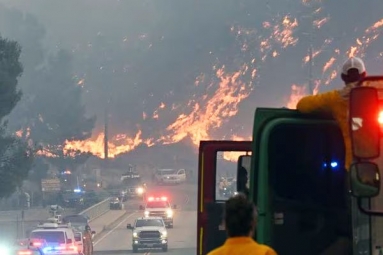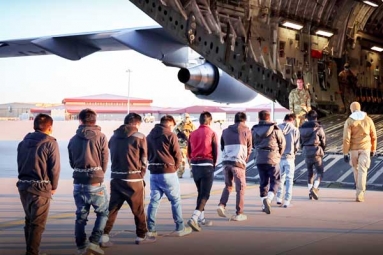Indian Youth Falling into Trap of Human Traffickers and Taking Dangerous Routes to Enter U.S., Canada
June 19, 2019 06:45
Human trafficking is currently a multi-million-dollar industry across the world with the chief target of traffickers being young men and women longing to settle in the United States or Canada. The increasing cases of human trafficking cases are reported in South America.
Reportedly, the U.S. Migrants from India, mailing hailing North and South states, Nepal, and Bangladesh has beenpaying between $30,000 to $50,000 for each journey into the United States or Canada.
Whether it the U.S. or Canada or any place in Europe, the charges are negotiable for crossing the borders of various countries. In case the person cannot afford to pay up he/she then decides to stay back in the South American Region and seek employment to earn enough to move on. They choose to work in groups in places like local restaurants, in shops, in public areas selling local goods or at times getting involved in narco-trading. And some prefer a marital route to cross over.
According to the United Nations Office on Drugs and Crimes (UNODC) Asia Report “Global Study on Smuggling of Migrants-2018”, “Various countries in South and Central America are used as transit countries for migrant smuggling between South and South-West Asia and North America. Sometimes this is due to visa arrangements.”
These migrants avoid the U.S. airspace and they prefer to use the routes through countries including Ecuador, Guatemala, Chile, Brazil, Bolivia, El Salvador Paraguay, Peru, Costa Rica, Nicaragua, and Colombia. “And their final destination is Canada and the U.S. The U.S. is sometimes used as a transit point for moving to Canada,” states the UN report.
For instance, between 2009 and 2011, Indians used a visa waiver scheme for Indian nationals in Guatemala to gain easier access to the U.S. via Mexico. After the termination of this scheme by Guatemala, Ecuador, which had a similar program, emerged as a transit point for the smuggling of migrants from India.
According to a travel agent, “Often the route taken in Brazil is by travel visa or by cargo vessels and the onward journey is by bus, taxis and walking to reach Ecuador by crossing the borders. On reaching Brazil, they have many options: either they can travel by crossing borders of Paraguay - Bolivia-Brazil - Colombia - Ecuador or through Amazonia Jungle (Brazil) - Colombia - Ecuador.”
Dangerous Route Explained
Explaining the dangerous route taken, a young migrant from rural Punjab told Financial Express Online that, “We move through Ecuador to Panama via Colombia by taxi and walking through the jungles. On reaching Turbo, Colombia, we start our journey through Darién Gap. This Gap is a lawlesswilderness on the border of Colombia and Panama, teeming with everything from deadly snakes to anti-government guerrillas. It starts in Turbo, Colombia and ends in Yaviza, Panama which is 106 km (66 miles) long. And we can only cover this by walking. Some immigrants use boats from Ecuador to bypass Colombia, and the Panama Jungles and move directly to Costa Rica, Nicaragua or El Salvador” which is life risk.”
The United Kingdom, Spain, and the Syrian Arab Republic are also used as transit points to smuggle migrants from South-West Asian countries to North American, the UN report stated quoting British authorities.
According to the UN report, migrant smugglers often facilitate irregular movements by air from India. The scale of migrant smuggling by air from India is corroborated by data about people apprehended while trying to irregularly leave India from the major international airports in the country.
Between 2008 and August 2012, 1,173 cases of irregular migration were recorded at Indira Gandhi International airport in New Delhi, points out the UN report. Most of those departing were Indians, but citizens of many other countries - Afghans, Bangladeshis and Sri Lankans in large numbers - were also detected. And, nearly 20 percent of these travelers were heading towards either the U.S. or Canada.
Some East and South-East Asian migrants pay smugglers to arrange a fake marriage with a Canadian or American citizen in order to enter those countries. Others may be smuggled by air directly to the U.S. or via a neighboring country.
The young men and women land in the most obscure cities in the South American nations without knowing the language and from there onwards their adventure starts. Some perish due to disease, boat capsizing, drowning, or get picked by local gangs while crossing through jungles in countries like Guatemala or El Salvador. And those who survive in case they are unable to pay the smuggler, they get innovative and use GPS on their phones to cross borders.
While Ecuador is under concurrent accreditation of the Indian embassy in Bogota, in the recent past, the Colombian authorities deported Indian men who were trying to get into Ecuador. In 2018, Colombia Migration has detected 1,200 irregular migrants who were from India, Bangladesh, Nepal, and Cameroon. On average, each migrant pays a thousand dollars for their passage through Colombia.
Stringent Action Against Traffickers
Several diplomats from South and Central America region confirmed that trafficking has turned to be a threat and they are working with the Indian government as well as the Indian missions to ensure stringent action is taken against the traffickers.
Despite strict monitoring by Indian missions in South America, especially in Colombia, Panama, Ecuador, Chile, Argentina, Uruguay, and Mexico, there has been no significant change in the illegal movement of human traffic. In the last couple of years, Punjab government has registered cases against several travel agencies in Punjabafter a boatload of 24 youth had capsized in Panama and there were no survivors.
“Unless effective action is taken against Indian agents, illegal activities will continue unabated from North and South India,” said an Indian diplomat.
All things are arranged by human trafficking Agents. The Indian agent has the responsibility to ensure that that Indian can get migration in Latin American region. Once the person reaches the South or Central America the local agent takes over. This local agent’s responsibility is to provide the immigrant with fake documents, paperwork, food, stay, onward journey and entry into the final country of destination.
By Sowmya Sangam







